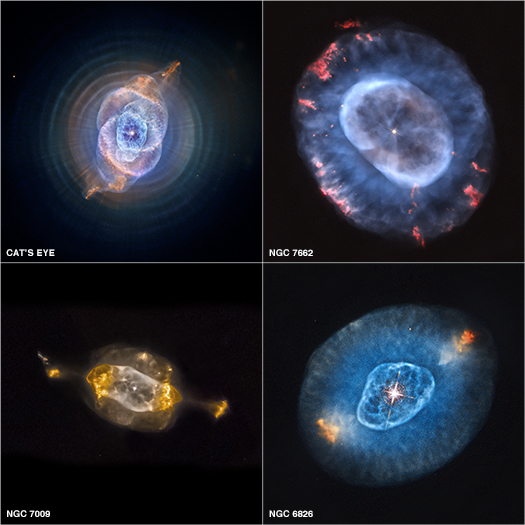|
IC 2574
IC 2574, also known as Coddington's Nebula, is a dwarf spiral galaxy discovered by American astronomer Edwin Foster Coddington in 1898. Located in Ursa Major Ursa Major, also known as the Great Bear, is a constellation in the Northern Sky, whose associated mythology likely dates back into prehistory. Its Latin name means "greater (or larger) bear", referring to and contrasting it with nearby Ursa M ..., a constellation in the northern sky, it is an outlying member of the M81 Group. It is believed that 90% of its mass is in the form of dark matter. IC 2574 does not show evidence of interaction with other galaxies. It is currently forming stars; a UV analysis showed clumps of star formation 85 to 500 light-years (26 to 150 pc) in size. References Dwarf spiral galaxies Intermediate spiral galaxies Magellanic spiral galaxies Ursa Major M81 Group 2574 05666 30819 Discoveries by Edwin Foster Coddington Astronomical objects discovered in 1898 {{Spiral-galaxy-s ... [...More Info...] [...Related Items...] OR: [Wikipedia] [Google] [Baidu] |
Ursa Major
Ursa Major, also known as the Great Bear, is a constellation in the Northern Sky, whose associated mythology likely dates back into prehistory. Its Latin name means "greater (or larger) bear", referring to and contrasting it with nearby Ursa Minor, the lesser bear. In antiquity, it was one of the original 48 constellations listed by Ptolemy in the 2nd century AD, drawing on earlier works by Greek, Egyptian, Babylonian, and Assyrian astronomers. Today it is the third largest of the 88 modern constellations. Ursa Major is primarily known from the asterism of its main seven stars, which has been called the "Big Dipper", "the Wagon", "Charles's Wain", or "the Plough", among other names. In particular, the Big Dipper's stellar configuration mimics the shape of the " Little Dipper". Two of its stars, named Dubhe and Merak ( α Ursae Majoris and β Ursae Majoris), can be used as the navigational pointer towards the place of the current northern pole star, Polaris in Ursa Mino ... [...More Info...] [...Related Items...] OR: [Wikipedia] [Google] [Baidu] |
Institute Of Physics
The Institute of Physics (IOP) is a UK-based not-for-profit learned society and professional body that works to advance physics education, physics research, research and applied physics, application. It was founded in 1874 and has a worldwide membership of over 20,000. The IOP is the Physical Society for the UK and Ireland and supports physics in education, research and industry. In addition to this, the IOP provides services to its members including careers advice and professional development and grants the Professional qualifications in the United Kingdom, professional qualification of Chartered Physicist (CPhys), as well as Chartered Engineer (UK), Chartered Engineer (CEng) as a nominated body of the Engineering Council; it also holds its own separate Royal Charter. The IOP's publishing company, IOP Publishing, publishes 85 academic titles. History The Institute of Physics was formed in 1960 from the merger of the Physical Society of London, Physical Society, founded as ... [...More Info...] [...Related Items...] OR: [Wikipedia] [Google] [Baidu] |
Principal Galaxies Catalogue Objects
Principal may refer to: Title or rank * Principal (academia), the chief executive of a university ** Principal (education), the head of a school * Principal (civil service) or principal officer, the senior management level in the UK Civil Service * Principal dancer, the top rank in ballet * Principal (music), the top rank in an orchestra Law * Principal (commercial law), the person who authorizes an agent ** Principal (architecture), licensed professional(s) with ownership of the firm * Principal (criminal law), the primary actor in a criminal offense * Principal (Catholic Church), an honorific used in the See of Lisbon Places * Principal, Cape Verde, a village * Principal, Ecuador, a parish Media * ''The Principal'' (TV series), a 2015 Australian drama series * ''The Principal'', a 1987 action film * Principal (music), the lead musician in a section of an orchestra * Principal photography, the first phase of movie production * "The Principal", a song on the album ''K- ... [...More Info...] [...Related Items...] OR: [Wikipedia] [Google] [Baidu] |
UGC Objects
UGC may refer to: Organisations * Canadian Geophysical Union, official abbreviation in French (Union géophysique canadienne) * UGC (cinema operator), a European cinema chain, formerly Union Générale Cinématographique * UGC Fox Distribution, a former French-American film production company formed in 1995 * Union Graduate College, Schenectady, New York * United Grain Company, a Russian grain trading company based in Moscow * University Grants Commission (other) * University Grants Committee (other) * UnitedGlobalCom, former name of the cable TV operator Liberty Global * UnderGround Crips, an African American street gang mainly from Los Angeles, California Science and technology * Universal gravitational constant G, in physics * Uppsala General Catalogue, an astronomical catalogue of galaxies * UGC, a codon for cysteine * Unique games conjecture, a conjecture in computational complexity Other * User-generated content User-generated content (UGC), a ... [...More Info...] [...Related Items...] OR: [Wikipedia] [Google] [Baidu] |
IC Objects
The ''New General Catalogue of Nebulae and Clusters of Stars'' (abbreviated NGC) is an astronomical catalogue of deep-sky objects compiled by John Louis Emil Dreyer in 1888. The NGC contains 7,840 objects, including galaxies, star clusters and emission nebulae. Dreyer published two supplements to the NGC in 1895 and 1908, known as the ''Index Catalogues'' (abbreviated IC), describing a further 5,386 astronomical objects. Thousands of these objects are best known by their NGC or IC numbers, which remain in widespread use. The NGC expanded and consolidated the cataloguing work of William and Caroline Herschel, and John Herschel's ''General Catalogue of Nebulae and Clusters of Stars''. Objects south of the celestial equator are catalogued somewhat less thoroughly, but many were included based on observation by John Herschel or James Dunlop. The NGC contained multiple errors, but attempts to eliminate them were made by the ''Revised New General Catalogue'' (RNGC) by Jack W. Sulenti ... [...More Info...] [...Related Items...] OR: [Wikipedia] [Google] [Baidu] |
Magellanic Spiral Galaxies
A Magellanic spiral galaxy is a spiral galaxy with only one spiral arm. Magellanic spiral galaxies are classified as the type Sm (with sub-categories SAm, SBm, SABm); the prototype galaxy and namesake for Magellanic spirals is the Large Magellanic Cloud, an SBm galaxy. They are usually smaller dwarf galaxies and can be considered to be intermediate between dwarf spiral galaxies and irregular galaxies. Magellanic spirals SAm galaxies are a type of unbarred spiral galaxy, while SBm are a type of barred spiral galaxy. Linda S. Sparke, John Sill Gallagher, ''Galaxies in the Universe: An Introduction'', 2ed., Cambridge University Press, 2007, SABm are a type of intermediate spiral galaxy. Type ''Sm'' and ''Im'' galaxies have also been categorized as irregular galaxies with some structure (type Irr-1). Sm galaxies are typically disrupted and asymmetric. dSm galaxies are dwarf spiral galaxies or dwarf irregular galaxies, depending on categorization scheme. The Magellanic spiral classi ... [...More Info...] [...Related Items...] OR: [Wikipedia] [Google] [Baidu] |
Intermediate Spiral Galaxies
An intermediate spiral galaxy is a galaxy that is in between the classifications of a barred spiral galaxy and an unbarred spiral galaxy. It is designated as SAB in the galaxy morphological classification system devised by Gerard de Vaucouleurs. Subtypes are labeled as SAB0, SABa, SABb, or SABc, following a sequence analogous to the Hubble sequence for barred and unbarred spirals. The subtype (0, a, b, or c) is based on the relative prominence of the central bulge and how tightly wound the spiral arms Spiral arms are a defining feature of spiral galaxies. They manifest as spiral-shaped regions of enhanced brightness within the galactic disc. Typically, spiral galaxies exhibit two or more spiral arms. The collective configuration of these arms ... are. Examples References * Galaxy morphological types {{Spiral-galaxy-stub ... [...More Info...] [...Related Items...] OR: [Wikipedia] [Google] [Baidu] |
Dwarf Spiral Galaxies
A dwarf spiral galaxy is the dwarf version of a spiral galaxy. Dwarf galaxies are characterized as having low luminosities, small diameters (less than 5 kpc), low surface brightnesses, and low hydrogen masses. The galaxies may be considered a subclass of low-surface-brightness galaxies. Dwarf spiral galaxies, particularly the dwarf counterparts of Sa–Sc type spiral galaxies, are quite rare. In contrast, dwarf elliptical galaxies, dwarf irregular galaxies, and the dwarf versions of Magellanic type galaxies (which may be considered transitory between spiral and irregular in terms of morphology) are very common. It is suggested that dwarf spiral galaxies can transform into dwarf elliptical galaxies, especially in dense cluster environments. Examples * NGC 5474 * NGC 3928 * NGC 625 * NGC 1051 * NGC 1311 * NGC 5949 Location Most identified dwarf spiral galaxies are located outside clusters. Strong gravitational interactions between galaxies and interactions between gal ... [...More Info...] [...Related Items...] OR: [Wikipedia] [Google] [Baidu] |
Indian Institute Of Technology Kanpur
The Indian Institute of Technology Kanpur (IIT- Kanpur or IIT-K) is a public institute of technology located in Kanpur, Uttar Pradesh, India. As an Indian Institute of Technology (IIT), it was declared an Institute of National Importance by the Government of India under the Institutes of Technology Act. IIT Kanpur has been occasionally ranked among the best academic institutions in India. As of January 2025, at least 17 Padma Shri, 4 Padma Bhushan, 1 Padma Vibhushan, and 33 Shanti Swarup Bhatnagar Prize recipients have been affiliated with IIT Kanpur as alumni or faculty members. History IIT Kanpur was established by an Act of Parliament in 1960 by the Government of India. The institute was started in December 1959 in a room in the canteen building of the Harcourt Butler Technological University at Agricultural Gardens in Kanpur. In 1963, the institute moved to its present location, on the Grand Trunk Road near Kalyanpur locality in Kanpur district. The campus, which ... [...More Info...] [...Related Items...] OR: [Wikipedia] [Google] [Baidu] |
Arcmin
A minute of arc, arcminute (abbreviated as arcmin), arc minute, or minute arc, denoted by the symbol , is a unit of angular measurement equal to of a degree. Since one degree is of a turn, or complete rotation, one arcminute is of a turn. The nautical mile (nmi) was originally defined as the arc length of a minute of latitude on a spherical Earth, so the actual Earth's circumference is very near . A minute of arc is of a radian. A second of arc, arcsecond (abbreviated as arcsec), or arc second, denoted by the symbol , is a unit of angular measurement equal to of a minute of arc, of a degree, of a turn, and (about ) of a radian. These units originated in Babylonian astronomy as sexagesimal (base 60) subdivisions of the degree; they are used in fields that involve very small angles, such as astronomy, optometry, ophthalmology, optics, navigation, land surveying, and marksmanship. To express even smaller angles, standard SI prefixes can be employed; the milliarcse ... [...More Info...] [...Related Items...] OR: [Wikipedia] [Google] [Baidu] |
California Institute Of Technology
The California Institute of Technology (branded as Caltech) is a private research university in Pasadena, California, United States. The university is responsible for many modern scientific advancements and is among a small group of institutes of technology in the United States that are devoted to the instruction of pure and applied sciences. The institution was founded as a preparatory and vocational school by Amos G. Throop in 1891 and began attracting influential scientists such as George Ellery Hale, Arthur Amos Noyes, and Robert Andrews Millikan in the early 20th century. The vocational and preparatory schools were disbanded and spun off in 1910, and the college assumed its present name in 1920. In 1934, Caltech was elected to the Association of American Universities, and the antecedents of NASA's Jet Propulsion Laboratory, which Caltech continues to manage and operate, were established between 1936 and 1943 under Theodore von Kármán. Caltech has six academic divisi ... [...More Info...] [...Related Items...] OR: [Wikipedia] [Google] [Baidu] |
NASA
The National Aeronautics and Space Administration (NASA ) is an independent agencies of the United States government, independent agency of the federal government of the United States, US federal government responsible for the United States's civil list of government space agencies, space program, aeronautics research and outer space, space research. National Aeronautics and Space Act, Established in 1958, it succeeded the National Advisory Committee for Aeronautics (NACA) to give the American space development effort a distinct civilian orientation, emphasizing peaceful applications in space science. It has since led most of America's space exploration programs, including Project Mercury, Project Gemini, the 1968–1972 Apollo program missions, the Skylab space station, and the Space Shuttle. Currently, NASA supports the International Space Station (ISS) along with the Commercial Crew Program and oversees the development of the Orion (spacecraft), Orion spacecraft and the Sp ... [...More Info...] [...Related Items...] OR: [Wikipedia] [Google] [Baidu] |







